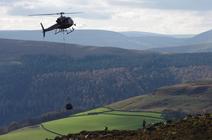Our conservation team is always busy and 2017 showed no signs of slowing down. Check out these figures from September- December 2017 to give you an idea of how much work takes place.
(Science speak: a hectare is roughly the same size as a football field!)

Bleaklow
Land owned by the National Trust and private landowners on the iconic Bleaklow received impressive amounts of conservation work.
Heather brash was spread on almost 10 hectares. Heather brash contains heather seeds and lichens and is flown onto site and spread by hand.
Cutting for sward diversification (this is when some plant species are cut back to allow other plant species to grow) took place on 25 hectares. The area also received 150 hectares of lime, seed and fertiliser treatment.
2420 dams were installed to help to slow the flow of water and raise the water level back to healthy blanket bog levels. Sphagnum moss, which is a building-block of blanket bogs was then planted onto 24.5 hectares. This process of spreading brash to planting sphagnum is crucial for returning areas of bare peat to healthy blanket bogs.
Black Hill area
Black Hill is north of Bleaklow and is crossed by the famous Pennine Way. The area is situated above Oldham and Stalybridge. Due to this area being so close to the big industrial city of Manchester, it was badly hit by industrial pollution and has needed extensive conservation treatment.
660 heather bale dams were installed. Heather bale dams are semi-permeable meaning they let some of the water seep through whilst stopping the sediment from eroding off the moor. 80 hectares of sphagnum plug plants were planted onto this beautiful part of the world, so have a lookout for this fantastic bog moss next time you’re walking the Pennine Way.
Snailsden Moor
56 timber dams were installed on this magnificent moor, which lies just south of Holmfirth. Timber dams are deliberately leaky so that they can trap rainfall and release it slowly thus slowing the flow of water. Over 34 hectares of sphagnum was also planted onto Snailsden.
Marsden
Marsden is the furthest north of all these sites and is named after the rural village of Marsden which it sits above. The area is a famous beauty spot and with 40 hectares of sphagnum planted, it’s going to be even more stunning!
Kinder
The famous Kinder is located above the village of Edale and received some treatment for tackling bracken. We undertake bracken spraying in some areas to stop it taking over the whole area- which it has a tendency of doing. 60 hectares of bracken were sprayed which now means the area can be home to lots of different plants, insects and animals.
Well done team, partners, and volunteers- a fantastic effort!
You can discover more about the stages of repairing bare peat – including stabilising, spreading heather brash, lime seed and fertiliser, and gully blocking – here.
Find out more about sphagnum’s incredible qualities.